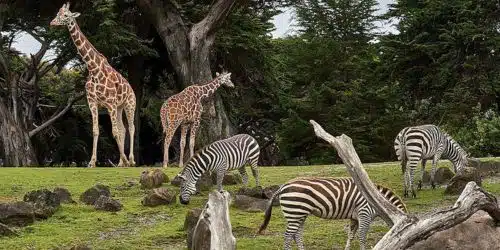The beautiful state of Texas is home to some of the biggest, hippest, and greatest zoos in the country, stretching from Fort Worth to Houston. Aside from learning about exotic animals, you might never get to visit in their natural habitats, you’ll also find some interesting displays.
A trip to a Texas zoo may liven up a trip to the Lone Star State, whether you’re traveling with friends, family, or alone. Many of the state’s zoos are dedicated to tourist satisfaction and animal conservation. I enjoyed spending time alone exploring the Fort Worth zoos, seeing the orangutans, gorillas, and monkeys play in their natural settings, and having animal encounters like bathing elephants. You can find the best zoos to visit close to you in Texas, thanks to the state’s abundance of zoos, aquariums, and safaris.
Best Zoo in Texas
Take some time to bring the whole family or go with friends if you live close to one of the following zoos or are visiting the area and want to experience some amazing animal adventures. It will be a victory for everyone, whichever zoo you choose.
These zoos are frequently praised for their high standards, thoughtfully created environments, captivating exhibits, and contributions to both entertainment and education.
The ultimate Texas zoo guide is provided here.
#1. Fort Worth Zoo
It’s at the top of our list because USA Today ranked it as the best zoo in the country.
At this zoo, there is constantly a fresh, exciting event going on. It was founded in 1909, making it the oldest zoo as well.
What distinguishes this zoo from others? There are currently 540 species there, including 172 ectotherm species, 148 bird species, and 72 animal species.
They also provide two fantastic displays. Elephant Springs is now being expanded, but visitors can still see the elephants that are on display.
#2. Dallas Zoo
Even though this North Texas zoo is only a short distance from downtown Dallas, once you enter it, it will seem like another planet. Visit the Wild Encounters Stage to get up close and personal with a variety of creatures, including interesting reptiles, free-flying birds, porcupines, and more. They have a large number of unusual animal species. Seasonal variations in ticket costs exist.
#3. San Antonio Zoo
A 35-acre park in San Antonio, Texas, houses the San Antonio Zoo. There are about 3,500 creatures living there, representing over 750 different species, some of which are endangered. The San Antonio Zoo provides a range of educational activities and events in addition to participating in conservation initiatives.
#4. Houston Zoo
Many of the visitors’ favorite creatures, such as Asian elephants, southern white rhinos, Malayan tigers, western lowland gorillas, African lions, and more, can be seen in outdoor wildlife habitats.
There is now a Night at the Zoo option. On Thursday, you can participate in a behind-the-scenes tour of what zookeepers do when the animals wind down for the night.
#5. Austin Zoo
There are currently approximately 300 animals here, representing more than 100 different species, and it is a non-profit rescue zoo.
The collection of animals contains creatures that are being retired from other facilities because of their age, health, or other problems.
#6. San Antonio Zoo
At the moment, the zoo is home to around 300 animals from over 100 different species. Our collection of animals comprises animals that are being retired from other facilities due to old age, ill health, or other problems.
Throughout the year, they also provide a drive-through zoo. San Antonio is a fantastic weekend escape because there is so much to do there.
#7. Caldwell Zoo
The Texas city of Tyler is home to an 85-acre zoo. It includes creatures from several zoos. It includes creatures from several zoos.
They provide summer camps for children as well as classes through ZooSchool, which meets once a month for a total of six sessions.
#8. Texas State Aquarium
Help our staff feed and engage with many of our creatures, including birds, sharks, and even sea turtles, and get a glimpse into our displays that few people get to see.
Because of its proximity to the Gulf of Mexico, this zoo is well known for its marine species. One species that everyone travels to see is the marine turtle.
#9. Fossil Rim Wildlife Center
Two hours from DFW, a Texas-sized safari gives you the impression that you are on another continent.
An excellent site to see exotic animals in their natural habitat is this drive-through park. One bag of animal feed can be bought per automobile. Bring binoculars with you so you can see the wildlife from the overlooks.
Expect to spend many hours traveling through the park, which has a 7-mile road and more than 1,000 animals. A café and gift shop are located about halfway along the road.
Features of Zoos in Texas
Numerous renowned zoos with a wide range of exhibits, educational activities, and events may be found throughout Texas. The following are some characteristics of zoos in Texas:
#1. Large Size
The Dallas Zoo and the Fort Worth Zoo are just two examples of Texas’ numerous, sizable zoos that span more than 100 acres of space. As a result, there is plenty of room for both tourists and animals to roam.
#2. Extensive Animal Variety
Elephants, lions, tigers, giraffes, and a vast range of other creatures can be found in Texas zoos. Some zoos, like the Houston Zoo, have more than 6,000 animals from over 900 different species.
#3. Conservation initiatives
Texas has a large number of zoos that participate in conservation initiatives to preserve endangered species and their ecosystems. For instance, the San Antonio Zoo maintains a conservation program that focuses on the preservation of various threatened species, such as African wild dogs and black rhinos.
#4. Educational Initiatives
For visitors of all ages, Texas zoos provide a range of educational activities. Programs could include interactions with animals, behind-the-scenes tours, and educational talks.
#5. Distinctive Features
Each zoo in Texas has distinctive qualities that distinguish it from the others. For instance, the Gladys Porter Zoo in Brownsville offers a botanical garden with more than 250 varieties of plants, while the Dallas Zoo hosts a summertime performance series called Safari Nights.
#6 Interactive Displays
In Texas, there are many zoos with interactive displays that let visitors get close to the animals. For instance, the Houston Zoo has a platform where guests can feed giraffes.
#7. Playgrounds
Children’s play spaces at some zoos in Texas include playgrounds and water features. For instance, the Fort Worth Zoo features a splash pad and a fossil dig area.
#8. Special Occasions
Texas zoos frequently host annual special events, including animal-themed festivals, holiday light shows, and fundraising activities. For instance, the San Antonio Zoo holds an annual Zoo La-La celebration with food, beverages, and live music.
#9. Animal Welfare
The health and welfare of the animals are top priorities for Texas zoos. This includes offering suitable housing, food, and medical attention.
#10. Research
Texas has a large number of zoos that carry out studies on animal behavior, reproduction, and conservation. This study contributes to bettering zoo and wild animal management and care.
#11. Volunteering Possibilities
In Texas, zoos frequently have volunteer opportunities available for anyone who wishes to get involved and lend a hand. Volunteers could help with special events, educational initiatives, or animal care.
Activities Available at Texas Zoos
The following are things you can do at zoos.
#1. Observe and engage with animals
Visitors can witness a range of animals in Texas zoos, including both exotic and native fauna. Additionally, some zoos provide interactive exhibits where guests can interact directly with the animals.
#2. Ride a train.
The T-Rex Express Mini-Train, an all-electric trackless train featuring animal designs, is available for use by visitors to the Dallas Zoo to explore the zoo.
#3. Attend exceptional events
Many zoos in Texas, including the San Antonio Zoo and the Houston Zoo, hold unique events all year long, such as festivals with an animal theme and fundraising activities.
#4. Gain knowledge of conservation initiatives.
In Texas, zoos frequently have displays and educational activities that inform visitors about efforts being made to protect endangered animals and their ecosystems.
#5. Eat and shop
Texas zoos offer gift shops for souvenir shopping, as well as on-site dining options for guests.
#6. Take part in educational initiatives
Texas’s zoos provide a range of educational activities, such as animal interactions, behind-the-scenes tours, and instructional lectures, for visitors of all ages.
#7. Wander around the zoo grounds.
Texas zoos frequently feature wide grounds to explore, a variety of ecosystems to see, and beautiful scenery to take in.
#8. Go on a tour with a guide
In Texas, numerous zoos provide competent professional or volunteer-led guided tours. These excursions provide visitors with a closer look at the zoo’s creatures and displays.
#9. Participate in animal feedings and shows
Animal feedings and demonstrations are frequently organized at zoos in Texas, giving visitors a rare chance to observe the animals up close and discover more about their habitats and behaviors.
#10. Attend animal programs
In certain Texas zoos, trained animals display a variety of behaviors and tricks during animal shows. These programs may be an enjoyable approach to discovering more about animals.
#11. Go on a carousel or another type of amusement ride.
Several Texas zoos offer amusement rides for guests to enjoy, including trains, carousels, and other kid- and family-friendly attractions.
#12. Engage in practical actions
A few zoos in Texas provide visitors with interactive exhibits, petting zoos, and other hands-on experiences.
#13. Appreciate seasonal events
Texas zoos frequently provide seasonal activities like Easter egg hunts, pumpkin patches, and holiday light displays.
#14. Take pictures
Texas’s zoos provide plenty of possibilities for visitors to capture pictures of the animals and the zoo’s surroundings. Some zoos even have spaces intended for taking pictures or providing visitors with photography classes.
Activities Prohibited in Texas Zoos
The particular prohibited behaviors in zoos in Texas can differ, but you might run into the following guidelines and limitations:
#1. Animal Feeding
It is not permitted for visitors to feed the animals because doing so could alter their diets and possibly jeopardize the animals’ health.
#2. Contact with Animals
It is frequently forbidden to touch or attempt to physically contact animals since it could stress them and endanger people.
#3. Entering Prohibited Areas
Only authorized workers are allowed in several areas of the zoo, particularly the hidden or off-limits ones.
#4. Bringing Animals
It’s typically not permitted to bring personal animals to the zoo for reasons of health and safety.
#5. Smoking
Due to the potential harm smoking can do to people, animals, and the environment, several zoos have designated smoking areas or outright banned it.
#6. Leave-taking
In general, littering is prohibited since trash can be bad for the environment and wildlife.
#7. Disruptive Behavior
Visitors are required to act politely and refrain from inappropriate or disruptive behavior that could annoy other guests or animals.
#8. Illegal Photography
Photography could be prohibited in some zoos, especially if it entails using a flash or upsetting the animals.
#9. Scaling or Getting Over Barriers
In most cases, it is strictly forbidden for safety reasons to climb over fences, overpass barriers, or access spaces that are not intended for guests.
#10. Guidelines for food and drinks
Regarding the use of outside food and beverages on zoo grounds, several zoos have specific rules.
What Is the Largest Zoo in Texas?
The Dallas Zoo, which is over 106 acres in size and is home to more than 2,000 animals representing over 400 distinct species, is the biggest in Texas.
What Is the Number One Zoo in the US?
The Henry Doorly Zoo and Aquarium in Omaha, Nebraska, is the top zoo in the US. One of the top zoos in the world, according to ratings given time and time again. Based on several criteria, the zoo is rated as the best in the US. The number and variety of animals, the standard of the exhibits and habitats, the educational and conservation activities, and the overall tourist experience are all factors. The zoo has constantly made investments in brand-new attractions. For instance, one of the largest exhibits in North America, the African Grasslands Show, has 28 acres of land. The zoo is renowned for its top-notch conservation and research initiatives, as well as its immersive and engaging visitor experiences.
Where Is the USA’s Biggest Zoo?
The Columbus Zoo and Aquarium in Ohio, which spans 580 acres, is the largest in the US. North of Columbus, in Liberty Township, Delaware County, Ohio, the Columbus Zoo and Aquarium is a nonprofit zoo. It is close to Powell. The zoo is one of the biggest in the US and is home to about 10,000 animals from over 600 different species. The zoo offers guests unique and engaging experiences in addition to its pop-up zookeeper shows and animal interactions.
What Is The Dallas Zoo Known For?
The Dallas Zoo is renowned for its sizable animal collection, which comprises more than 2,000 creatures from more than 400 species. The zoo is renowned for its conservation efforts as well as its work to breed and study okapi and other creatures. The zoo is renowned for providing visitors with immersive and engaging experiences. Like the Giants of the Savanna exhibit and the Wilds of Africa display, two of the biggest zoo habitats in the world. With elephants, giraffes, zebras, and other African creatures, it has a mixed species habitat.
Summary
Visitors to zoos in Texas can expect a variety of engaging experiences. They provide interactive exhibits, emphasize conservation efforts, include a variety of animal species, and construct naturalistic habitats. Family-friendly events, presentations, and activities improve the visitor’s experience while promoting the protection of wildlife. Visitors of all ages can be entertained and educated while also learning about conservation at each zoo.
- BEST ZOOS IN CHICAGO IN 2023
- IS SUPPORT PETS LEGIT? 2023 REVIEWS
- Best Places to Travel in April: 2023 Exhaustive List (Updated)
- SPIRIT AIRLINES PET POLICY: All You Need To Know
- BEST HOTELS IN LUBBOCK, TEXAS IN 2023-2024






